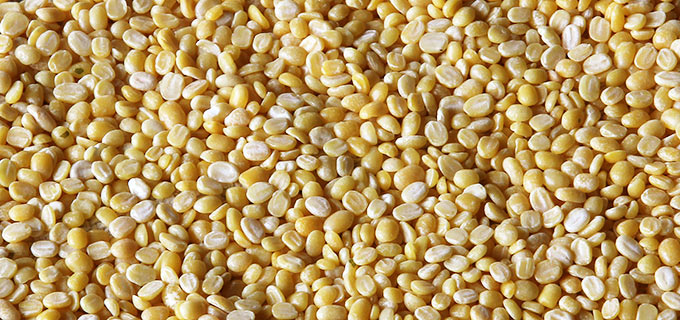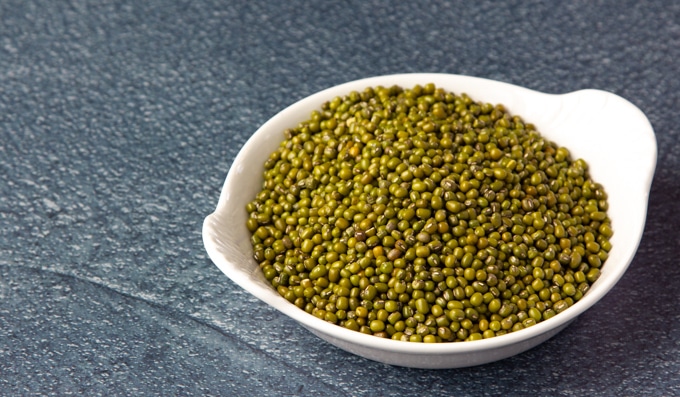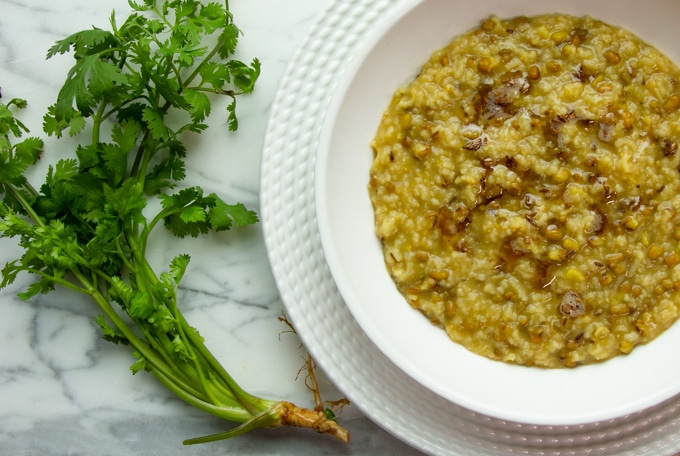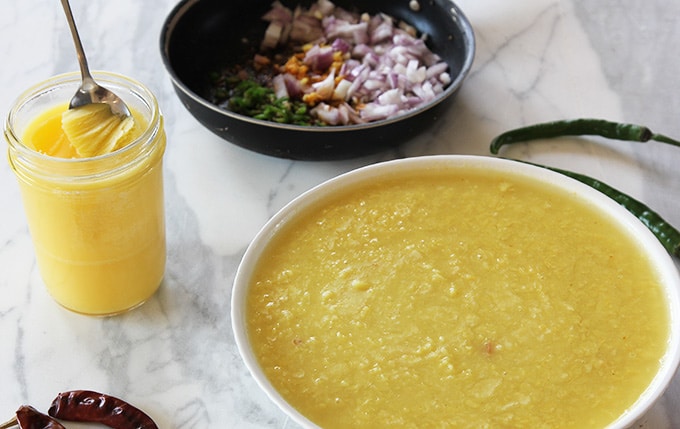This post may contain affiliate links. Please see our disclosure for more information.
The humble moong dal (also known an mung bean or green gram) is most valued of all pulses and legumes in Ayurveda.
Moong dal is highly balancing, and the easiest to digest of all the legumes, so if you’ve had trouble digesting beans and lentils in the past, consider trying again with moong dal, because the health benefits of consuming legumes are too numerous to be missed.
Moong dal is the hulled and split form of the popular mung bean. Mung beans are tiny in size and moss-green colored, while moong dal is yellow. Despite the different names, they are the same.


I personally enjoy both the green and yellow forms very much.
In Ayurveda, a dish made with moong dal, known as khichdi, is the equivalent of a chicken soup in the West, or congee in China. It is very healing, and easy to digest when a person is feeling unwell.
Moong dal really is a superfood
Regular consumption of moong dal is recommended in the Charaka Samhita (an ancient authoritative text of Ayurveda).
By regular consumption, that could be as often as daily, or at least a few times a week. Moong dal is also safe for infants and toddlers, and the elderly.
This comes back to the easy-to-digest quality of moong dal. In Ayurveda, good digestion is the key to health.
It was nice to find that research published in the American Journal of Plant Sciences backs up the ancient claims about moong dal.
Compared to other legumes, researchers found that mung bean starch is easier to digest, resulting in fewer problems with gas. It is also relatively low in phytic acid, an anti-nutrient that has a negative impact on iron and zinc bioavailability.
What I personally find most notable about moong dal is its soluble fiber content. There is a sticky, mucilaginous texture that comes out after cooking the moong dal. It’s similar to the gel you may have noticed on well-cooked oatmeal.
That insoluble fiber is very soothing and healing for the digestive tract, and supportive for gut health.
According to Dr. Axe, soluble fiber prolongs stomach emptying, which improves absorption of nutrients, provides satiety after eating, and controls hunger.
I have to say that after eating a lot of moong beans over a 2-week period of cleansing recently, I genuinely felt that reduction in hunger. In fact, I lost 6.5 pounds. So that’s pretty amazing.
Qualities of moong dal that are mentioned in the Charaka Samhita (ancient Ayurvedic text)
- Slightly sweet and astringent taste
- Cooling and drying
- Light on digestion
- Balances kapha and pitta dosha, and is superior to the other pulses
- One of the few legumes that work for vata
Qualities of moong dal that are mentioned in the ancient Yogratnakara text of Ayurveda
- It can be taken all year by all ages and body types.
- It is especially beneficial for the injured, as it helps in the healing of wounds
- Beneficial for throat disorders like cough, tonsillitis, pharyngitis
- Maintains health of the thyroid gland
- Advised in eye disorders like conjunctivitis, glaucoma, dry eyes, and glare in vision
- Improves peristaltic motion of the gastrointestinal tract
- Provides nutrition to the tissues of the body
- Reduces symptoms of heartburn
- Soothes the skin and reduces rashes
- When consumed regularly, it improves hair texture and density
- Provides strength to the body
- Balances the secretions of the glands in general
Nutritional benefits
Since Ayurveda prizes moong dal so much, I went on a serious hunt to try to understand why it’s recommended over all others.
It took me a while to find the evidence. If you refer to my link, go to page 232, and refer to the green gram line.
What I found is that compared to other legumes, moong dal is off the charts for it’s calcium, magnesium, phosphorus, manganese and potassium content.
It is also contains a respectable amount of iron and zinc, while its protein content is on the low end compared to other legumes.
Moong dal is for khichdi
Part of the reason moong dal holds a special place is Ayurveda is due to the fact that it is the key ingredient in khichdi, which is one of Ayurveda’s most famous dishes known in the West.
Khichdi is a satisfying one pot dish, made with moong dal, basmati rice, spices, and ghee.
If you go on an Ayurvedic cleanse, regular consumption of khichdi is the recommended food.
Recommended recipes
My favorite Khichdi, made with mung dal.

A simple and comforting yellow dal, made with split yellow moong dal.

Moong dal is for cleansing and digestive support
One of the tastes that supports cleansing is the astringent taste, and moong dal, as well as all legumes, have the astringent taste.
Because the astringent taste is drying, it helps to clean up mucus and congestion, and tone up the digestive tract.
Legumes, such as moong dal are high in fiber, and this is highly beneficial for digestion.
During the digestion of fiber, there is a mild scraping action in your digestive tract that removes mucus, toxins, and even parasites, from the walls of your colon.
The high soluble fiber content in mung dal makes this cleansing process super gentle.
I also want to let you know that the smaller the legume is, the easier it is to digest, and moong dal is definitely tiny.
Do I need to soak moong beans?
Soaking legumes for 4 hours or overnight is always supportive for digestion. After soaking, you will drain and rinse 4-6 times until the water runs clear.
This process removes some of the water-soluble proteins that sometimes interfere with digestion.
Soaking is particularly beneficial for people with weak digestion.
Soaking also helps to hydrate the legume. It will make the cooking time shorter, and sometimes results in a softer legume.
Moong beans, because they are split and tiny, can be cooked without soaking. I would still rinse it a few times before cooking.
Where can I buy moong dal?
Specialty and natural grocers, such as Whole Foods, may stock moong dal.
An Indian grocery store will definitely have it.
Or you can buy it online.
> Here is a recommendation on Amazon. Note that this Amazon price is about double what you would pay at an Indian grocery store.
Would you like to know more about how to incorporate Ayurvedic cooking into your life for health, happiness, and healing?
I offer a 6-week program, called Happy Eater – LEARN MORE
I also offer Ayurvedic Health Consultations – LEARN MORE
And a 30-minute free discovery call – SCHEDULE NOW
